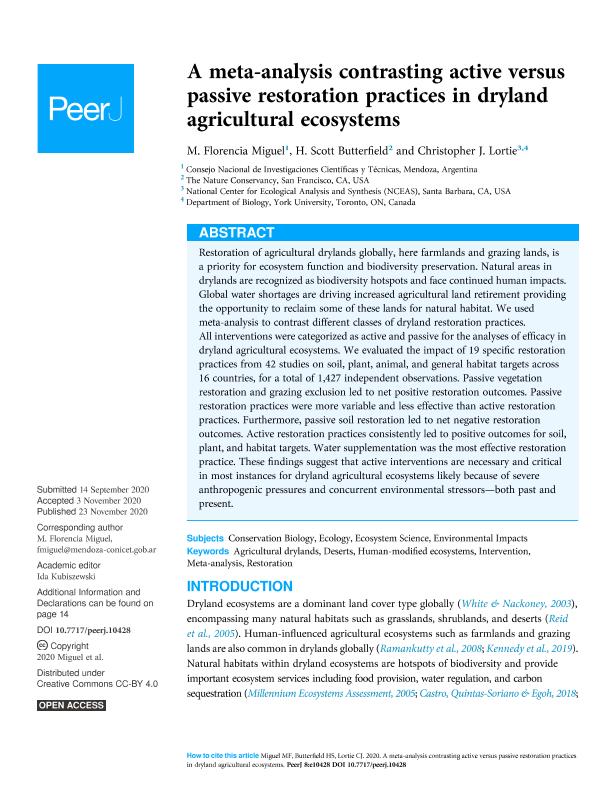Mostrar el registro sencillo del ítem
dc.contributor.author
Miguel, María Florencia

dc.contributor.author
Butterfield, H. Scott
dc.contributor.author
Lortie, Christopher J.
dc.date.available
2021-09-30T19:00:33Z
dc.date.issued
2020-11
dc.identifier.citation
Miguel, María Florencia; Butterfield, H. Scott; Lortie, Christopher J.; A meta-analysis contrasting active versus passive restoration practices in dryland agricultural ecosystems; PeerJ Inc.; PeerJ; 8; 11-2020; 1-19
dc.identifier.uri
http://hdl.handle.net/11336/142149
dc.description.abstract
Restoration of agricultural drylands globally, here farmlands and grazing lands, is a priority for ecosystem function and biodiversity preservation. Natural areas in drylands are recognized as biodiversity hotspots and face continued human impacts. Global water shortages are driving increased agricultural land retirement providing the opportunity to reclaim some of these lands for natural habitat. We used meta-analysis to contrast different classes of dryland restoration practices. All interventions were categorized as active and passive for the analyses of efficacy in dryland agricultural ecosystems. We evaluated the impact of 19 specific restoration practices from 42 studies on soil, plant, animal, and general habitat targets across 16 countries, for a total of 1,427 independent observations. Passive vegetation restoration and grazing exclusion led to net positive restoration outcomes. Passive restoration practices were more variable and less effective than active restoration practices. Furthermore, passive soil restoration led to net negative restoration outcomes. Active restoration practices consistently led to positive outcomes for soil, plant, and habitat targets. Water supplementation was the most effective restoration practice. These findings suggest that active interventions are necessary and critical in most instances for dryland agricultural ecosystems likely because of severe anthropogenic pressures and concurrent environmental stressors—both past and present.
dc.format
application/pdf
dc.language.iso
eng
dc.publisher
PeerJ Inc.
dc.rights
info:eu-repo/semantics/openAccess
dc.rights.uri
https://creativecommons.org/licenses/by/2.5/ar/
dc.subject
AGRICULTURAL DRYLANDS
dc.subject
DESERTS
dc.subject
HUMAN-MODIFIED ECOSYSTEMS
dc.subject
INTERVENTION
dc.subject
META-ANALYSIS
dc.subject
RESTORATION
dc.subject.classification
Ecología

dc.subject.classification
Ciencias Biológicas

dc.subject.classification
CIENCIAS NATURALES Y EXACTAS

dc.title
A meta-analysis contrasting active versus passive restoration practices in dryland agricultural ecosystems
dc.type
info:eu-repo/semantics/article
dc.type
info:ar-repo/semantics/artículo
dc.type
info:eu-repo/semantics/publishedVersion
dc.date.updated
2021-09-06T19:58:20Z
dc.identifier.eissn
2167-8359
dc.journal.volume
8
dc.journal.pagination
1-19
dc.journal.pais
Estados Unidos

dc.description.fil
Fil: Miguel, María Florencia. Consejo Nacional de Investigaciones Científicas y Técnicas. Centro Científico Tecnológico Conicet - Mendoza. Instituto Argentino de Investigaciones de las Zonas Áridas. Provincia de Mendoza. Instituto Argentino de Investigaciones de las Zonas Áridas. Universidad Nacional de Cuyo. Instituto Argentino de Investigaciones de las Zonas Áridas; Argentina
dc.description.fil
Fil: Butterfield, H. Scott. The Nature Conservancy; Estados Unidos
dc.description.fil
Fil: Lortie, Christopher J.. York University; Canadá. National Center for Ecological Analysis and Synthesis; Estados Unidos
dc.journal.title
PeerJ
dc.relation.alternativeid
info:eu-repo/semantics/altIdentifier/url/https://peerj.com/articles/10428
dc.relation.alternativeid
info:eu-repo/semantics/altIdentifier/doi/http://dx.doi.org/10.7717/peerj.10428
Archivos asociados
